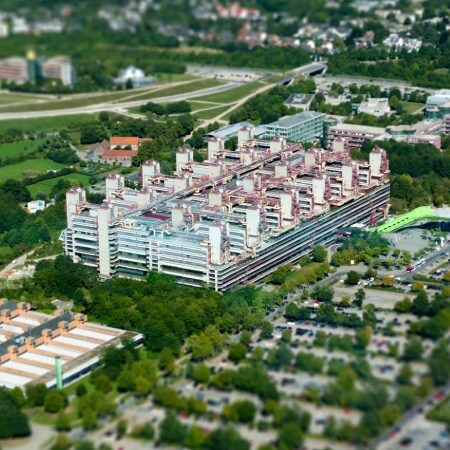Dermatofibrosarcoma protuberans (DFSP) is a rare soft tissue tumor affecting the skin and subcutaneous adipose tissue. Physically, the tumor is a slowly growing solid plaque. It most often develops on the torso in young people. A diagnosis is made by doing a skin biopsy. In Germany, the vast majority of cases are successfully treated. Clinics in Germany prefer the Mohs surgery, as it provides a 7-fold reduction in the risk of tumor recurrence compared to wide excision.
Content
- Mohs surgery
- Wide excision
- Drug therapy
- Radiation therapy
In Germany, the main treatment method is the Mohs microsurgery. The operation provides a low risk of recurrence and ensures excellent aesthetic results. After surgery, radiation therapy or drug therapy with tyrosine kinase inhibitors may be required.
You can undergo treatment in the following hospitals: University Hospital of Ludwig Maximilian University of Munich, University Hospital Frankfurt am Main, HELIOS Clinic Krefeld.
Please leave your request for the treatment of dermatofibrosarcoma on the Booking Health website, and our specialists will contact you immediately. They will help you select a clinic and a doctor, apply for a visa, get to the clinic, get medical insurance and communicate with doctors in the same language (interpreting services). Upon completing treatment and returning to your native country, you will be able to receive remote consultations from the attending physician until complete recovery.
Mohs surgery
Mohs micrographic surgery is considered the best treatment for dermatofibrosarcoma. This is a complex operation that is not performed in all medical centers. At the same time, it is the main one in German clinics.
The essence of the surgical technique is the multi-stage removal of the tumor, with a constant assessment of the state of the resection margin.
The doctor performs a tumor resection with minimal capture of the adjacent tissues. The material is then sent to the laboratory to assess the resection margin. After receiving the results, the doctor continues to cut the flaps, but only in the direction in which tumor cells are found. After each such stage, a repeated histological examination is carried out.
As a result, the operation can take several hours. It is continued until the resection margins are clear. Such an operation is more sparing and provides better aesthetic outcomes since the doctor does not have to remove tissue with a "reserve". This is especially important when the neoplasm is localized in areas where resection of a significant amount of tissue can lead to functional disorders.
Another advantage of the Mohs surgery is the low risk of tumor recurrence. It is associated with total histopathological control of the resection margin during surgery.
Wide excision
Wide excision is rarely used in developed countries, but this method is often used in countries with poorly developed medicine.
The essence of the surgical intervention is that the tumor is removed with an indentation of 2 to 4 cm from the visible margin of the neoplasm. The indentation depends on both the size of the tumor and its location, as well as on the requirements for the functional and aesthetic outcomes of the surgery.
After a wide local excision, the recurrence rate reaches 7,3%. At the same time, in the case of micrographic Mohs surgery, the probability of tumor recurrence is only 1%.
Dermatofibroma very rarely metastasizes to the lymph nodes, so in most cases, patients do not require additional surgical intervention on the lymphatic collector. As a result of refusing to remove lymph nodes, the treatment of the disease becomes less traumatic, the risk of complications is reduced, and the duration of oncological rehabilitation is reduced.
Drug therapy
The treatment of dermatofibrosarcoma in Germany involves using an oral tyrosine kinase inhibitor. Most patients do not require drug therapy. It is used for the following forms of dermatofibrosarcoma:
- recurrent (returning after primary treatment)
- unresectable (not subject to surgical removal)
- metastatic
The best response to the treatment is achieved in patients with t(17;22) translocation. This genetic disorder is detected by the results of molecular biological diagnostics. Fluorescence in situ hybridization (FISH) or reverse transcription polymerase chain reaction (RT-PCR) is used in Germany.
The course of treatment lasts 6 months, and it is effective in two-thirds of patients.
Radiation therapy
In the case of dermatofibrosarcoma, radiation therapy is not very common. This is due to the fact that surgery is enough to cure this disease in most patients. The areas of application of radiation therapy are as follows:
- after surgery – in case of high risk of recurrence
- destruction of the recurrent tumor
After surgery, most recurrences occur within the first 3 years. Therefore, the most accurate monitoring of patients is carried out during these periods. They are examined every 3 months in the first year and every 6 months in the next 2 years. Then the frequency of examinations can be reduced to 1 time in 12 months. With a high risk of recurrence, the list of diagnostic tests includes a chest CT scan.
Patients who want to undergo diagnostics and treatment of dermatofibrosarcoma in Germany can book a medical care program via the international medical tourism agency Booking Health. When using this service, prices will be lower for you due to the lack of additional coefficients for foreign patients. The cost of treatment is guaranteed not to increase, as you will receive insurance coverage up to 200,000 euros. On our website, you can find out the price for surgical interventions and conservative procedures in different clinics in Germany and book your treatment on the most suitable dates. The Booking Health specialists will select a clinic for you and take care of the arrangement of your trip.
Authors:
The article was edited by medical experts, board certified doctors Dr. Nadezhda Ivanisova and Dr. Sergey Pashchenko. For the treatment of the conditions referred to in the article, you must consult a doctor; the information in the article is not intended for self-medication!
Sources:
MedlinePlus
Sience Direct
PubMed




















